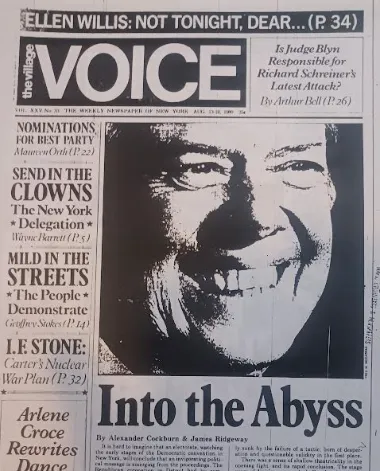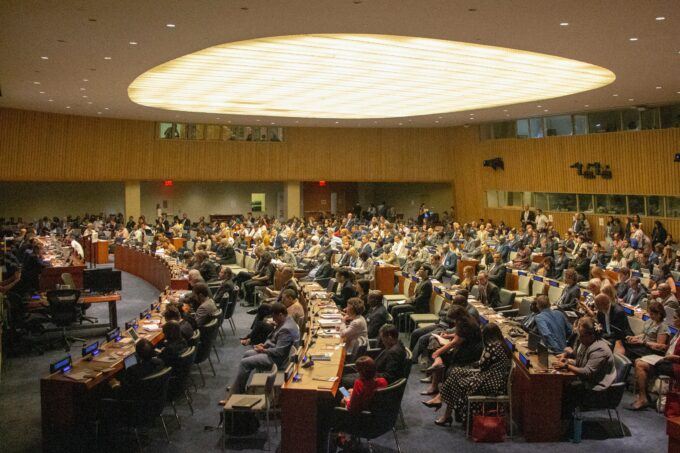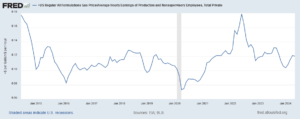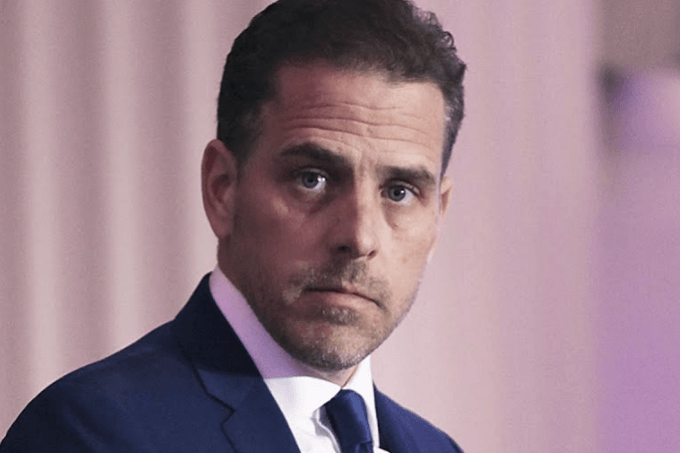
In what prosecutors called a “landmark ruling in the fight for human rights,” a U.S. jury in Miami has found banana giant Chiquita Brands International liable for the deaths of Colombian civilians due to its financing of the United Self-Defense Forces of Colombia (AUC), a brutal paramilitary death squad.
The AUC was responsible for thousands of civilian deaths and hundreds of other human rights violations while it was active between the late 1990s and mid-2000s, some of the most violent years of the Colombian civil war. The ruling holds Chiquita accountable for making hidden payments to the paramilitary organization from 1997 to 2004. Even in the early years, the group’s atrocities were already well documented not just in Colombian media, but also in the United States, where the State Department declared the AUC a terrorist organization in 2001.
After 17 years of legal proceedings, the first set of victims and their families have finally attained a measure of closure. The jury ruled that Chiquita must pay $38.3 million to plaintiffs in eight of the nine “bellwether” murder cases presented in the six-week trial.
The families brought the suit after Chiquita pleaded guilty in a U.S. criminal case in 2007 to making over 100 payments to the AUC totaling more than $1.7 million over more than six years.
“This historic ruling marks the first time that an American jury has held a major U.S. corporation liable for complicity in serious human rights abuses in another country, a milestone for justice,” EarthRights International, the NGO that represented plaintiffs, said in public statements immediately following the ruling.
As part of Colombia’s 2016 peace agreement with the Revolutionary Armed Forces of Colombia (FARC), the country created an independent transitional justice body to investigate crimes against humanity committed by both armed groups and Colombian security forces. The investigations have included cases like the “false positives” scandal, in which the military, with the aid of AUC forces, killed over 6,400 innocent civilians and recorded them as guerilla fighters to inflate rebel casualty statistics at the height of the civil war.
The Miami ruling in the Chiquita case represents a further step towards what Colombia’s peace court has called restorative justice—attempts to offer remedy and justice to the millions of victims killed, displaced, injured, or assaulted during the conflict.
Jurors in Miami sided with plaintiff’s claims that Chiquita Brands chose to profit from the bloodiest period of Colombia’s more than half-century conflict rather than abandon its operations in the country, and that the decision to fund death squads actively participating in that conflict meant the company was liable for the deaths of family members of victims in the case.
In an internal email sent in December 2003, a Chiquita Brands director wrote: “We appear to be committing a felony.” Yet the company continued financing the paramilitary group until well into the next year, according to court documents from the previous criminal case.
Families of the victims of the AUC in the Colombian regions of Urabá and Magdalena Medio have for years sought the right to sue the U.S. fruit giant in civil courts in both Colombia and the United States — petitions that Chiquita Brands delayed for nearly two decades with legal tactics in both countries.
Now, any final settlement with the families will likely involve further litigation and perhaps negotiations with the company. A second case featuring other victims with claims against Chiquita is set to begin preliminary hearings in July.
Chiquita has already announced it will appeal the decision, and unless the fruit giant offers a general settlement, EarthRights lawyers, who also represent other victims, have said they will continue to pursue further litigation in future cases. Chiquita’s legal troubles—including claims from more than a thousand victims in hundreds of cases, as well as a slow-moving criminal case in Colombia accusing executives of “aggravated conspiracy to commit a crime”—are far from settled.
“The struggle for justice is slow, but victory is possible, even against the wealthy and the powerful,” Tatiana Devia, a lawyer with EarthRights who worked on the case, said in a press conference following the verdict. Devia underlined that the ruling is “important for justice in Colombia as well.”
The case marks the first time a foreign company has been held liable for financing death squads in Colombia, an accusation that has also long been made against Coca-Cola, U.S. coal company Drummond, and Canadian mining giant Aris Mining (formerly Colombia Gold), among others.
Some experts suggest the Chiquita ruling could set a precedent in ongoing investigations into the actions of some of these companies as well.
Although the AUC nominally disarmed as part of an agreement with the government in 2006, many of their fighters simply re-armed and joined new criminal groups, perpetuating a dynamic that still fuels low intensity conflict in the country today.
Exacerbating and Profiting from Conflict
In addition to their arguments regarding the illicit paramilitary payments, attorneys for the plaintiffs also presented witnesses, including former AUC leaders and Chiquita employees, that accused the U.S. corporation of providing AUC forces with direct material assistance, including gasoline, transportation, and the use of shipping docks controlled by Chiquita Brands. The AUC used these resources to import weapons on multiple occasions.
Among the several former paramilitary leaders who testified in the trial was Salvatore Mancuso, one of the AUC’s most infamous commanders and a key witness in several ongoing investigations into paramilitary financing cases before Colombia’s transitional justice court.
Mancurso testified that Chiquita executives met personally with top paramilitary leader Carlos Castaño Gil, spokesman and political chief of the AUC, widely considered “the godfather of paramilitarism” in Colombia. The two parties negotiated payment in return for the AUC’s security services against left-wing rebel groups in the region, which had in previous years attacked Chiquita infrastructure.
Rather than denying the atrocities being committed by paramilitaries in those days, key witnesses for Chiquita’s defense stated that the AUC’s brutal reputation and propensity for human rights violations were well known by executives at the time—part of the company’s legal strategy of justifying executives’ actions by claiming that they agreed to work with the AUC only because they feared them.
Chiquita denies that the company should be held liable for violence perpetrated by paramilitary groups, arguing they were extorted by the AUC and financing was provided under duress and out of fear for their own safety and that of their employees.
However, another former AUC leader, Raúl Hasbún, testified that, contrary to the company’s claims, the paramilitaries never forced Chiquita to pay extortion fees. Nor did AUC forces ever attack Chiquita Brands operations institutionally—a fact that Charles “Buck” Keiser, who directed Chiquita’s operations in Colombia from 1987 to 2000, admitted under questioning during his own courtroom testimony on May 3.
On the contrary, the AUC, almost immediately after its formation as a paramilitary group in the region, provided Chiquita with security teams in multiple departments in the north of the country in exchange for regular financing in a relationship that plaintiffs described as “an equal partnership,” according to court documents.
At no point in this period did Chiquita choose to simply leave the country and extricate itself from Colombia’s spiraling conflict. Instead, EarthRights lawyers argued in court, “they chose to exacerbate and profit from” it.
According to court findings from the 2007 case, the company paid 3 cents on the dollar to AUC forces for each box of bananas exported from the country.
Remedies for a Debt Long Owed
As part of the 2007 investigation, Chiquita admitted to making illegal payments, as well as initially trying to conceal them as legitimate business expenditures. The company was fined $25 million in that case, but victims of the AUC never saw any of that money.
This latest ruling does not mean money is changing hands immediately, explained Marco Simons, lead counsel for EarthRights. This is but one case of many, which are part of “an ongoing process,” he said. “We hope that this win will pave the way for compensation and adequate remedies for all plaintiffs.”
For Ignacio Gómez, the verdict is a long-awaited personal vindication. He was the first journalist in Colombia to make these allegations public 21 years ago, and over the years he endured efforts by Chiquita Brands to suppress his work via lawsuits, as well as threats from paramilitary forces.
“I’ve been waiting years for this decision,” he told us. “And for Colombia, the importance of this decision cannot be understated.”
“Chiquita’s history in Latin America goes beyond this case,” he said, retelling the story of the “Banana Massacre” in Colombia, the slaughter of hundreds of striking plantation workers in the early 20th century, back when Chiquita went by another even more infamous name: the United Fruit Company.
“This debt is finally starting to be paid,” Gómez continued. In a country still suffering the after-effects of 53 years of civil war, fueled at least in part by the actions of private sector companies like Chiquita Brands, “we have hundreds of thousands of reasons to celebrate this ruling.”
This article is syndicated in partnership with the North American Congress on Latin America (NACLA).
The post Victims Win Historic Victory Against Chiquita in Colombia Paramilitary Case appeared first on CounterPunch.org.
This content originally appeared on CounterPunch.org and was authored by Daniela Díaz Rangel and Joshua Collins.
This post was originally published on Radio Free.
















